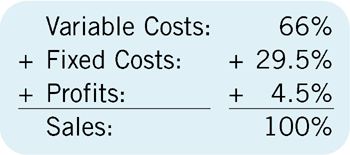
What is the one area of your business that, if you improved it by just 1 percent, would have the greatest impact on your business? To answer this question, we can gain insight by taking a look at the HVAC contracting industry "operating equation."

While the percentages given here will vary somewhat, depending on your target customer base, this example gives us an overall picture of a typical HVAC company from which to work.
Notice what part of the operating equation takes up the largest percentage of sales dollars. By far, the largest costs in the HVAC contracting industry operating equation are found in variable costs, which include labor, equipment, and materials. In fact, for many companies, variable costs are double that of fixed costs, otherwise known as overhead. Would it not, therefore, make sense to focus your attention on improving the variable portion of your company's operating equation first? That is not to say that we should ignore overhead; by all means, overhead expenses must be diligently controlled.
However, rather than throwing more money into ineffective (unmeasured) advertising and other overhead expenses, you should explore what would happen if you improved your variable cost efficiencies. If, by training and organizing your technicians, you could complete more work with fewer people, would you not save on fixed and certain variable expenses?
Labor-related burden expenses, such as workers' compensation insurance, would be reduced as a percentage of sales. The need to purchase additional vehicles and equipment would be reduced, saving on depreciation, insurance, and maintenance expenses. Sales would be increased as better productivity allowed for higher sales per technician to be completed. As a result, variable costs, as a percentage of sales, would be reduced.
Many business owners focus on cutting overhead costs, while at the same time they have no idea what materials and inventory are on their technicians' trucks, their shops are unorganized and inefficient, they have no technician training programs in place, they have high callback rates, and they fail to have any form of productivity measurement systems in place. But they carefully watch that 30 percent of expenses called overhead. These contractors are effectively throwing away dollars to save pennies.
The key to improving profits in your business rests heavily on managing your variable costs and improving productivity. This will require implementing systems that include some element of technician training, purchasing controls, inventory management, and labor management. How your company implements these controls will depend upon your company's culture and your management style.
Measuring Performance
Once you have implemented process improvement controls in your business, you must have some method to measure performance, if you are to know whether or not these controls are successful. I will provide you with some general guidelines to work with regarding operating metrics in the HVAC contracting industry. However, these are only guidelines and will vary depending on your company's strategy, goals, and target market.
HVAC gross profits typically range from 30 percent to 50 percent of sales. If your company is heavily weighted towards new construction work, gross profit margins tend to run 30 percent to 40 percent of sales. Companies with a heavy replacement/retrofit customer base tend to have gross profit margins of 35 percent to 45 percent of sales. Companies that focus primarily on service and repair work tend to have gross profit margins of 50 percent to 60 percent of sales.

Here, total labor equals labor costs plus labor burden expenses, such as taxes, insurance, etc.
At a glance, you can tell how effective your company is at managing its labor force. This is also an effective means of measuring productivity across separate divisions of your company, such as installation productivity vs. service productivity.
I recommend that companies aim to achieve a gross profit/labor ratio of 2. That is for every $1 you pay out in technician labor costs, you should get back $2 in gross profit. The HVAC industry average lies between 1.5 and 2. The top 25 percent of the most profitable companies achieve an average ratio around 2, with an operating profit (before interest and taxes) of nearly 18 percent, according to a 2002 study by Financial Research Associates titled Financial Studies of the Small Business.
Thinking about moving into a larger building? How much space do you need to support your operations?

What may seem like a need for a larger building may be due to inefficient use of space or lack of organization and controls.
Based upon my own analysis, I recommend that your company achieve $800 in sales per square foot before upsizing to a larger facility. This can also be a guide for you when shopping for a new facility based upon projected sales. Understanding operating metrics is important. However, knowing which metrics to focus on is essential. By focusing most closely on the variable side of your company's operating equation, you stand to gain the most benefits for your time.
Next week: Determining how fast your company can grow.
Roberts is owner of Roberts Commercial Lending Co. LLC. He can be reached at 586-716-8329 or CommercialFnnc@aol.com.
Publication date: 04/05/2004

Report Abusive Comment